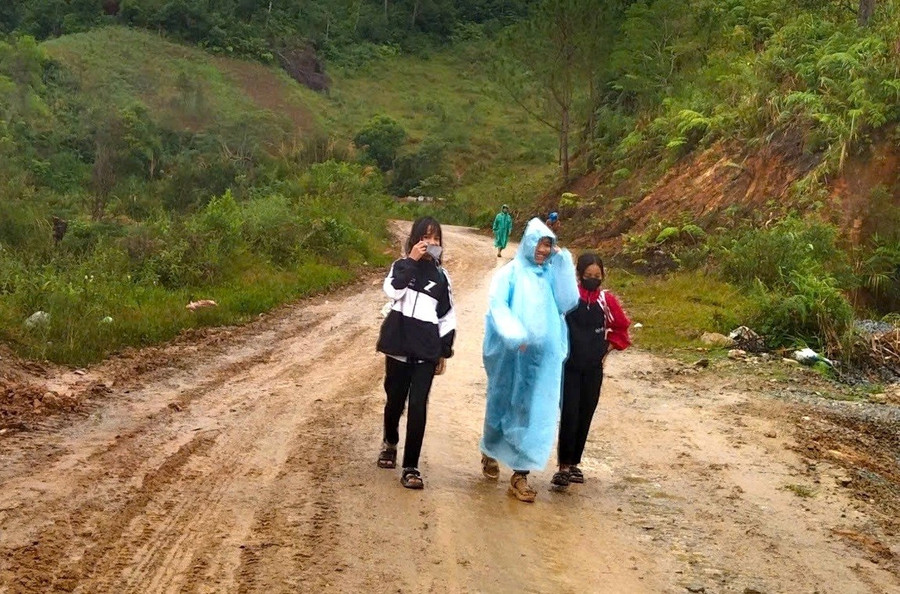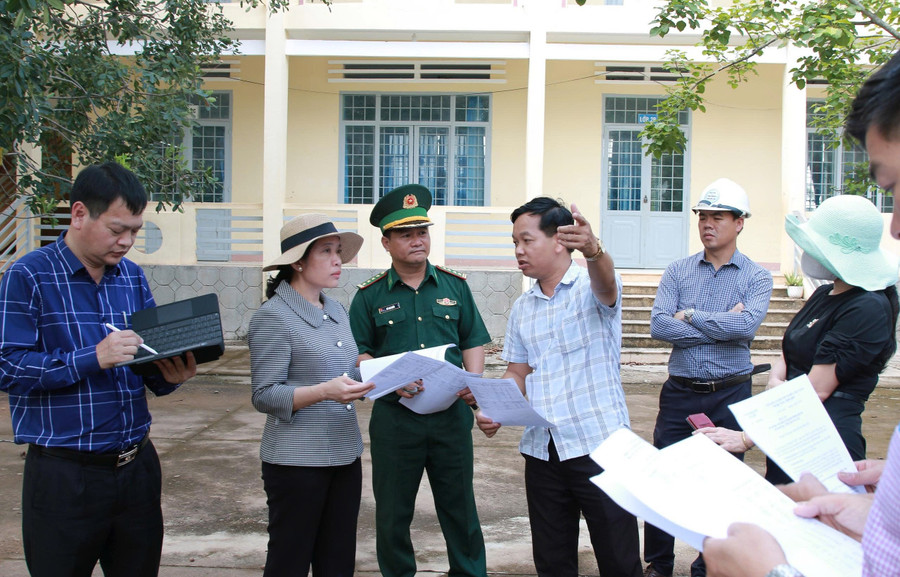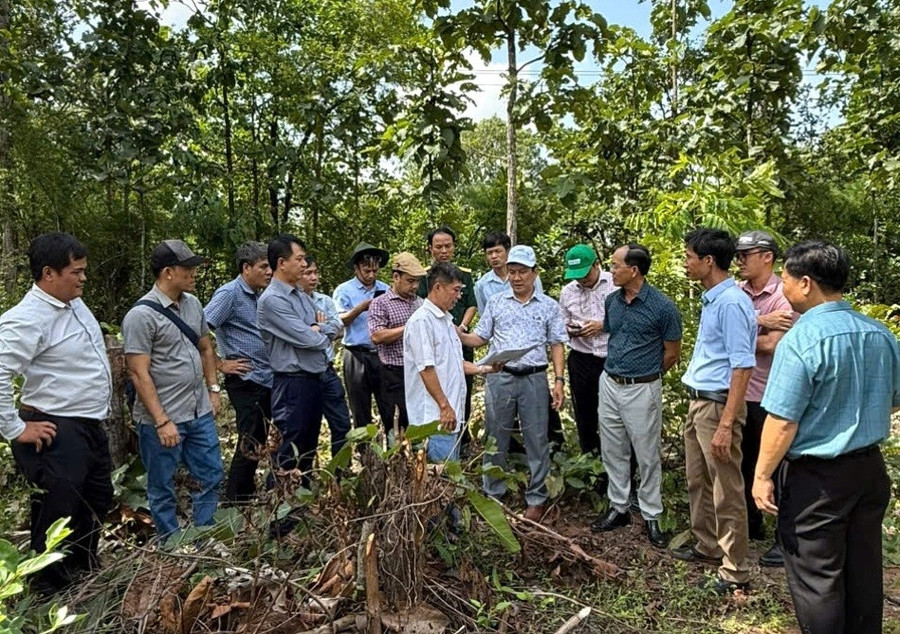Solid schools with full facilities, once a distant dream for poor students in the border areas, are now closer than ever. In the eyes of teachers and students here, joy is spreading.
Difficulty in maintaining classrooms in border areas
The dream of having a spacious school for poor students is gradually becoming a reality. Teachers and students do not have to worry about teaching and learning every time it rains heavily or is sunny. - Mr. DANG QUOC VU - Principal of Dak Plo Primary and Secondary School ( Quang Ngai )
In Gia Lai , Cu Chinh Lan Primary School (Ia Chia Commune) has 1 main campus and 6 satellite campuses. The main campus has 14 classes/12 classrooms, many classes have to study alternately in the morning and afternoon. Of these, 2 classrooms built before 2000 are severely damaged.
The supporting facilities are also lacking. The toilets shared by 400 students are often clogged and smelly. The library is temporarily located in an old, dilapidated classroom. When the rainy season comes, both teachers and students are worried that the classroom walls will collapse.
7km from the commune center, Nu 1 village school has 4 old classrooms. Ms. Pham Thi Thien, who has been with the school for more than 10 years, teaches a 4+5 combined class with 24 students, most of whom are ethnic minorities. "Many days when it rains heavily and the wind is strong, the classroom walls shake, and the teachers and students have to move out in the middle of the day," Ms. Thien said.
Not only primary schools, secondary schools in border areas also have many shortcomings. At Le Hong Phong Secondary School (Ia Chia Commune), the principal's office was renovated from an old boarding house, not enough space to store documents and there is no meeting room. Last May, a tornado blew off the roofs of three rooms of the teachers' official residence, forcing some teachers to temporarily stay in local houses or go home during the day even though the school year has not ended.
Similarly, Dak Lak has a 73km long border, adjacent to Mondulkiri province (Kingdom of Cambodia), including 4 communes: Ea Bung, Ia Rve, Ia Lop and Buon Don. Here, ethnic minorities account for over 50%, socio -economic conditions are still difficult, transportation is isolated and educational facilities are not uniform. These are major barriers affecting students' learning and training.
In the above communes, many students have to travel dozens of kilometers to get to school, facing danger during the rainy season. Parents worry when their children go to school far away, lacking caretakers. Teachers also have difficulty maintaining class sizes and improving teaching quality.
In Quang Ngai, Dak Plo and Xop communes are places where the rainy season lasts for many months. People's lives mainly depend on agriculture and support policies, but schools still face many difficulties. Dak Plo Primary and Secondary School has 340 students, most of whom are ethnic minority children. Of the 15 classrooms, only 6 are solid and were built in 2009, the rest are level 4 classrooms built in 1997, with many places having leaky roofs and cracked walls. The functional rooms are made from old classrooms.
Xop Commune Primary and Secondary School is also in a state of disrepair, with 8/21 classrooms having cracked walls and leaks. Desks and chairs are crooked, poorly lit, and there are no subject rooms, libraries, multi-purpose halls, or playgrounds. The official residence, built more than 20 years ago, is only big enough for a few teachers, many of whom have to rent rooms or go far away, affecting their health and teaching.

Hope from big policy
In the face of these difficulties, the policy of building inter-level boarding schools in 248 border communes in the mainland has brought great joy to teachers and students in disadvantaged areas. For teachers, this is not only good news, but also the hope of having solid classrooms, giving poor students a more adequate place to study in the middle of the mountains.
According to the survey, 4 key border communes of Dak Lak are managing 13 schools (7 primary schools, 6 secondary schools) with a total of more than 4,300 students. However, no commune has a model of inter-level boarding school, causing many limitations in organizing teaching and learning.
During the survey trip to the border communes, Director of the Department of Education and Training of Dak Lak - Le Thi Thanh Xuan directly assessed the current status of schools, land funds, water resources and enrollment needs. The goal is to determine the optimal solution: Build new or upgrade and expand existing facilities.
In Ia Rve commune, Chairman of the People's Committee Nguyen Van Hoa said that the locality is willing to "sacrifice" the economic benefits from the auctioned land fund (estimated at about 10 billion VND) to build a boarding school. The options being considered are upgrading and expanding Nguyen Thi Dinh Secondary School from the existing area of 1.4 hectares, or building a new one on vacant land near the commune People's Committee headquarters. This option is to ensure students' convenience in commuting, save costs and avoid wasteful investment.

Knowing that the survey team was surveying the site for the construction of an inter-level boarding school, Ms. Le Thi Dan (village 10, Ea Bung commune) shared: "With a boarding school, children will have their meals and sleep taken care of, and parents will feel much more secure." Meanwhile, Ha Hong Phuc (Ea Bung commune) hopes to soon study in the new school. "I like to study in a boarding school to be close to my friends and to be taken care of by my teachers. At noon, I don't have to cook for myself or walk far to get home," Phuc said.
Ia Lop (Dak Lak) is one of the four communes selected to build a boarding school. Mr. Pham Duy Tinh - Principal of Tran Hung Dao Secondary School, expressed: Spacious classrooms, synchronous facilities and teaching equipment, not only create convenience for teachers, but also are the premise to "pull" students to school, preventing them from dropping out of school.
“After the policy of building an inter-level boarding school was issued, we surveyed families with students living more than 5km away from the school. Most parents said that if they could stay and study at the boarding school and receive free accommodation, their children would be able to attend school regularly,” said Mr. Tinh, expressing concern that the local underground water source is heavily contaminated with alum, so investing in clean water projects is an important factor in ensuring living conditions for teachers and students.
Sharing the same view, Mr. Nguyen Van Son - Principal of Le Quy Don Secondary School (Ea Bung Commune), analyzed: "Boarding schools help parents feel secure in their work, reducing the risk of students dropping out of school. The school can coordinate closely with families, ensuring that students' studies are not interrupted."

Urgent survey and proposal to build school
According to the design, each inter-level ethnic boarding school in Dak Lak must accommodate about 1,000 students, with a minimum area of 4-5 hectares of computer rooms, sports areas and clean water systems. The total construction cost, fully invested in the following items: classrooms, dormitories, dining halls, libraries, 4 schools in Buon Don, Ea Bung, Ia Lop, Ia Rve, is estimated at about 420 billion VND.
Ms. Le Thi Thanh Xuan - Director of Dak Lak Department of Education and Training, emphasized: Investment plans must be realistic, ensuring convenience for students and parents, avoiding the situation of completing construction but not fully exploiting the functions. This is both an urgent and long-term task to develop human resources in border areas.
Moreover, the benefits of the model do not stop at solving the problem of accommodation and food for students. When living in a collective environment, students are trained in independence, discipline, life skills and solidarity. Teachers are also more convenient in managing and tutoring students, improving the overall quality of education.
After the merger, Quang Ngai province has 96 commune-level administrative units, of which 9 border communes bordering Laos and Cambodia, including: Po Y, Ia Toi, Dak Plo, Mo Rai, Duc Nong, Sa Loong, Dak Long, Ro Koi, Ia Dal.
Quang Ngai Department of Education and Training proposed to build 5 inter-level boarding schools, of which 2 schools will start construction in 2025 and be completed before August 30, 2026, including: Duc Nong Commune Primary - Secondary Boarding School with an area of about 4.6 hectares, total investment of about 207 billion VND and Mo Rai Commune Primary - Secondary Boarding School, area of about 5 hectares, cost of 175 billion VND.
The Department also proposed to build and renovate 3 schools, expected to be completed and put into use before August 30, 2027, but there are still problems with land funds. Specifically, the construction of a new Ia Dal Primary - Secondary Boarding School (area of about 6 hectares, cost of about 150 billion VND); renovation and upgrading of the Ro Koi Primary - Secondary Boarding School (on an area of about 1.8 hectares, investment of nearly 170 billion VND) and the Sa Loong Primary - Secondary Boarding School (area of about 3 hectares, investment of 70 billion VND). The remaining communes are proposed in the list of 148 communes in the next phase.
In Quang Ngai, investing in building schools for land border communes is a key task in socio-economic development and implementing ethnic policies. Thereby, improving people's knowledge and human resource quality, creating a source of ethnic minority cadres, contributing to improving the material and spiritual life of people in border areas.
According to Mr. Pham Van Nam - Director of Gia Lai Department of Education and Training, through the survey, the demand for studying at ethnic boarding schools and semi-boarding schools is very high. Meanwhile, the land fund does not meet the minimum area of 5 - 10 hectares to build inter-level boarding schools as prescribed. Most schools in border areas have substandard facilities, lacking classrooms, functional rooms, dining rooms and dormitories to serve the care and education of students.
In addition, there is a lack of items such as cultural and ethnic education activity houses, music and art rooms, and traditional rooms for students to both study and preserve and promote traditional cultural identity. In addition, the mobilization of social resources for investment in the above schools is still limited.
Faced with this situation, the Department of Education and Training of Gia Lai advised the Provincial People's Committee to prioritize capital allocation to build 7 new boarding schools for primary and secondary schools, meeting sufficient area and technical standards with a budget of more than 1,200 billion VND, expected to be put into use in 2026.
Along with that, increase investment in equipment, teaching aids and improve connecting infrastructure (electricity, water, traffic) to improve the quality of education and living conditions. The Department also proposed to build a specific regime and policy to support the teaching staff to create conditions for them to stick with and work long-term in border schools. At the same time, build a policy to support students to go to school, reducing the rate of dropouts.
Building boarding schools in border communes is urgent to ensure students' right to education, retain people and contribute to protecting the country's borders. - Mr. Nguyen Ngoc Thai (Director of the Department of Education and Training of Quang Ngai)
Source: https://giaoducthoidai.vn/xay-truong-noi-tru-vung-bien-gioi-noi-tinh-nguoi-thap-sang-tri-thuc-post746492.html



![[Photo] Lao President Thongloun Sisoulith and President of the Cambodian People's Party and President of the Cambodian Senate Hun Sen visit the 95th Anniversary Exhibition of the Party Flag Lighting the Way](https://vphoto.vietnam.vn/thumb/1200x675/vietnam/resource/IMAGE/2025/9/2/3c1a640aa3c3495db1654d937d1471c8)
![[Photo] Special art program "Da Nang - Connecting the future"](https://vphoto.vietnam.vn/thumb/1200x675/vietnam/resource/IMAGE/2025/9/2/efdd7e7142fd45fabc2b751d238f2f08)

![[Photo] Ho Chi Minh City residents show their affection to celebrate the 80th anniversary of the August Revolution and National Day September 2](https://vphoto.vietnam.vn/thumb/1200x675/vietnam/resource/IMAGE/2025/9/3/55d860cbb63a40808e1e74ad9289b132)

![[Photo] National Assembly Chairman Tran Thanh Man meets with First Secretary and President of Cuba Miguel Diaz-Canel Bermudez](https://vphoto.vietnam.vn/thumb/1200x675/vietnam/resource/IMAGE/2025/9/2/c6a0120a426e415b897096f1112fac5a)

























































































Comment (0)